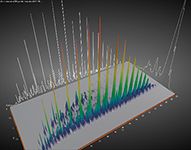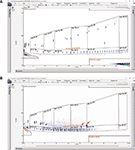GC×GC–FID for Routine Analysis of Total Petroleum Hydrocarbons
The Application Notebook
This study describes a flow-modulated GC×GC–FID system for the analysis of total petrochemical hydrocarbons (TPH) in environmental media, which offers improved performance compared to approaches based on solvent fractionation.
Petroleum contamination is of significant concern for both the environment and human health, and thorough characterization of the contamination is required to form appropriate risk assessments and remediation strategies. A number of risk-based methods have been developed for the analysis of extractable petroleum hydrocarbons in environmental media, but these methods typically use time-consuming solid-phase extraction to separate aliphatics and aromatics, and require two separate GC–FID analyses per sample. Sample fractionation is not only slow and labor-intensive, but it also incurs high costs due to consumable requirements.
Furthermore, differences in sorbent packing within the SPE cartridges can cause compounds to elute into the wrong fraction, while multiple sample handling steps increase the chance of contamination or error, requiring the sample (or even the whole batch) to be repeated.
Routine GC×GC–FID
SepSolve's product package for TPH analysis uses the enhanced separation capacity of comprehensive two-dimensional chromatography (GC×GC) (Figure 1). This optimized method enables aliphatics and aromatics to be fully separated in a single run, so eliminating the need for off-line sample fractionation and multiple analyses.

Faster, more affordable sample preparation: The elimination of off-line fractionation steps significantly reduces consumable costs associated with TPH analysis (Table I), and reduces waste disposal requirements by eliminating use of dichloromethane. GC×GC–FID analysis of a single sample with minimal sample handling also minimizes the chance for human error, by simplifying extraction.

Simple and reliable data processing: The structured ordering of GC×GC chromatograms ensures that chemical classes elute together in well-defined bands, simplifying group-type analysis. At the same time, interferences such as column bleed elute well away from the analytes of interest.
The intuitive ChromSpace® software platform that is part of the product package provides fast and simple data processing. By employing "stencils" defined by a banding standard (Figure 2), real-world samples can be quickly integrated and quantified. Note that only peaks integrated within a mesh are reported in the area percent table.

Method robustness: The purpose of the modulator in GC×GC is to sample the first-column effluent and "re-inject" it onto the second column in narrow bands. Thermal modulators require expensive liquid nitrogen or bulky chiller units to provide a cold jet to trap analytes, while flow modulators work using a simple, valve-based approach to "fill" and "flush" a sample loop. Flow modulation delivers increased method robustness-specifically the repeatability of retention times-through precise flow control by a dedicated EPC for each column. Flow modulators are therefore better suited to routine GC×GC analyses and comparisons across large sample batches.
Early adopters of GC×GC for TPH analyses have demonstrated the suitability of the technique through UKAS and MCERTS accreditation. Here we use SepSolve's INSIGHT™ flow modulator, which uses reverse fill and flush dynamics (as opposed to forward fill and flush), enabling sharp, symmetrical peaks to be obtained with no risk of chemical breakthrough between the aliphatic and aromatic regions.
Dual injection for unparalleled productivity: A unique feature of SepSolve's TPH product package is the ability to analyze two samples simultaneously. By configuring two modulators within the same GC oven, dual injection can be used to double the productivity of the analysis, providing a swift return on investment.

SepSolve Analytical Ltd.
22 Commerce Road, Lynch Wood, Peterborough, UK
tel. +44 (0)1733 669222, email hello@sepsolve.com
Website: www.sepsolve.com

Separation of Ultra-Short and Long Chain PFAS Compounds Using a Positive Charge Surface Column
December 11th 2024A separation of ultra-short and long chain PFAS (C1-C18) is performed on a HALO®PCS Phenyl-Hexyl column along with a HALO®PFAS Delay column which demonstrates excellent retention for both hydrophilic and hydrophobic analytes.












